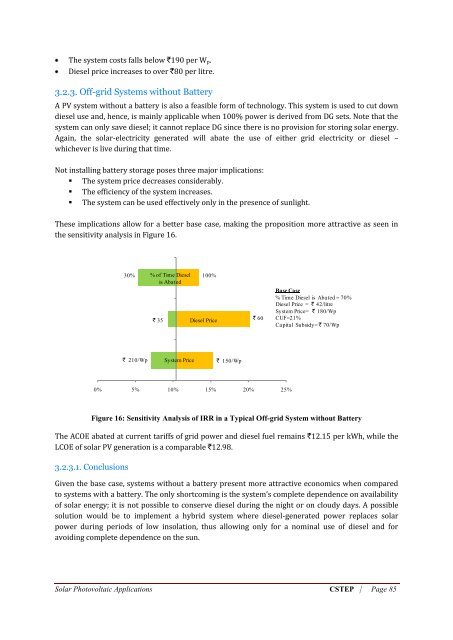Harnessing Solar energy, Options for India
A study on harnessing solar energy options for India was conducted recently by Shakti Sustainable Energy Foundation, Climate works Foundation and SSN foundation. Supporting this study it has been concluded that solar energy can play a big role in providing electricity to rural areas and thus has been included in India’s rural electrification policy. See more at: http://shaktifoundation.in/report/harnessing-solar-energy-options-for-india/
A study on harnessing solar energy options for India was conducted recently by Shakti Sustainable Energy Foundation, Climate works Foundation and SSN foundation. Supporting this study it has been concluded that solar energy can play a big role in providing electricity to rural areas and thus has been included in India’s rural electrification policy. See more at: http://shaktifoundation.in/report/harnessing-solar-energy-options-for-india/
You also want an ePaper? Increase the reach of your titles
YUMPU automatically turns print PDFs into web optimized ePapers that Google loves.
The system costs falls below `190 per W p.<br />
Diesel price increases to over `80 per litre.<br />
3.2.3. Off-grid Systems without Battery<br />
A PV system without a battery is also a feasible <strong>for</strong>m of technology. This system is used to cut down<br />
diesel use and, hence, is mainly applicable when 100% power is derived from DG sets. Note that the<br />
system can only save diesel; it cannot replace DG since there is no provision <strong>for</strong> storing solar <strong>energy</strong>.<br />
Again, the solar-electricity generated will abate the use of either grid electricity or diesel –<br />
whichever is live during that time.<br />
Not installing battery storage poses three major implications:<br />
• The system price decreases considerably.<br />
• The efficiency of the system increases.<br />
• The system can be used effectively only in the presence of sunlight.<br />
These implications allow <strong>for</strong> a better base case, making the proposition more attractive as seen in<br />
the sensitivity analysis in Figure 16.<br />
30% % of Time Diesel 100%<br />
is Abated<br />
` 35 Diesel Price<br />
` 60<br />
Base Case<br />
% Time Diesel is Abated = 70%<br />
Diesel Price = ` 42/litre<br />
System Price= ` 180/Wp<br />
CUF=21%<br />
Capital Subsidy= ` 70/Wp<br />
` 210/Wp<br />
System Price<br />
` 150/Wp<br />
0% 5% 10% 15% 20% 25%<br />
Figure 16: Sensitivity Analysis of IRR in a Typical Off-grid System without Battery<br />
The ACOE abated at current tariffs of grid power and diesel fuel remains `12.15 per kWh, while the<br />
LCOE of solar PV generation is a comparable `12.98.<br />
3.2.3.1. Conclusions<br />
Given the base case, systems without a battery present more attractive economics when compared<br />
to systems with a battery. The only shortcoming is the system’s complete dependence on availability<br />
of solar <strong>energy</strong>; it is not possible to conserve diesel during the night or on cloudy days. A possible<br />
solution would be to implement a hybrid system where diesel-generated power replaces solar<br />
power during periods of low insolation, thus allowing only <strong>for</strong> a nominal use of diesel and <strong>for</strong><br />
avoiding complete dependence on the sun.<br />
<strong>Solar</strong> Photovoltaic Applications CSTEP | Page 85

















